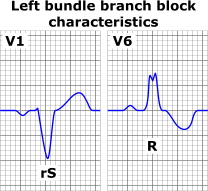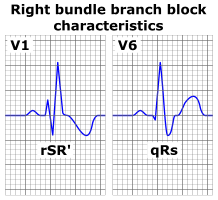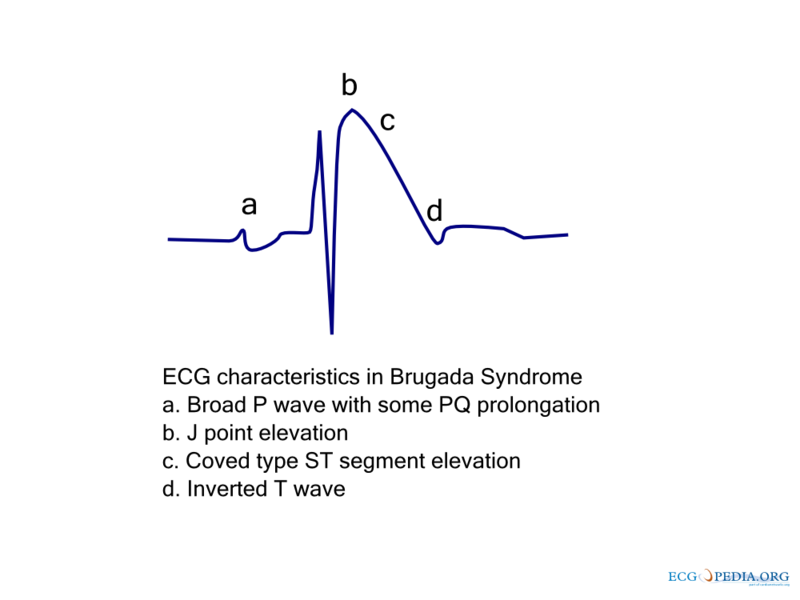Intraventricular conduction delay electrocardiogram
|
Intraventricular conduction delay Microchapters |
|
Differentiating Intraventricular conduction delay from other Disorders |
|---|
|
Diagnosis |
|
Treatment |
|
Case Studies |
|
Intraventricular conduction delay electrocardiogram On the Web |
|
Intraventricular conduction delay electrocardiogram in the news |
|
Blogs on Intraventricular conduction delay electrocardiogram |
|
to Hospitals Treating Intraventricular conduction delay electrocardiogram |
|
Risk calculators and risk factors for Intraventricular conduction delay electrocardiogram |
Editor-In-Chief: C. Michael Gibson, M.S., M.D. [1]; Associate Editor(s)-in-Chief: Mugilan Poongkunran M.B.B.S [2]
Overview
Intraventricular conduction delay is a common clinical abnormality detected on the electrocardiogram (ECG). Right and left bundle branch blocks usually reflect intrinsic impairment of conduction in either the right or left bundle system (intraventricular conduction disturbances) which can be either chronic or intermittent. Transient rate-related bundle branch blocks occurs when the heart rate increases (tachycardia or acceleration-dependent) or when heart rate decreases (bradycardia or deceleration-dependent) which are relatively rare.
Electocardiogram
Complete Left Bundle Branch Block
- QRS duration ≥120 msec in adults
- Abnormal interventricular septum activation :
- Absent q waves in leads I, V5, and V6, but in the lead aVL, a narrow q wave may be present in the absence of myocardial disease.
- Normal right ventricular activation :
- The findings in the right precordial leads is due to the electronically predominant septum and left ventricle.
- An rS or QS pattern in lead V1.
- Small or absent initial r waves in right precordial leads V1 and V2 followed by deep S waves.
- Delayed left ventricular activation :
- Broad notched or slurred R wave in leads I, aVL, V5, and V6 and an occasional RS pattern in V5 and V6 attributed to displaced transition of QRS complex.
- R wave peak time >60 msec in leads V5 and V6 but normal in leads V1, V2, and V3, when small initial r waves can be discerned in the above leads.
- Abnormal ventricular repolarization :
- The ST segment and T wave are discordant with the QRS complex.
- ST and T waves usually opposite in direction to QRS.
- Positive T wave in leads with upright QRS may be normal (positive concordance). The ST segment is usually depressed and the T wave is inverted in leads with positive QRS waves (e.g., leads I, aVL, V5, and V6).
- Depressed ST segment and negative T wave in leads with negative QRS (negative concordance) are abnormal. The ST segment is usually elevated and the T wave is upright in leads with negative QRS complexes (e.g., leads V1 and V2).
- QRS axis :
- In some cases, the mean QRS axis may change in the frontal plane to the right, to the left, or superiorly, in a rate-dependent manner.

Copyleft image obtained courtesy of ECGpedia, http://en.ecgpedia.org/wiki/Main_Page
Incomplete Left Bundle Branch Block
- QRS duration is of 110 to 119 milliseconds.
- Abnormal interventricular septum activation by RBB : Absence of q wave in leads I, V5, and V6 and frequent replacement by a slurred initial upstroke (pseudo-delta wave).
- Normal right ventricular activation : Small or absent initial r waves in right precordial leads V1 and V2 followed by deep S waves.
- Delayed left ventricular activation : R wave peak time longer than 60 milliseconds in leads V4, V5, and V6. Slurring and notching of the upstroke of tall R waves. The pattern commonly is similar to that of LVH.
Right Bundle Branch Block
- QRS duration ≥120 msec in adults
- Normal interventricular septum activation :
- Small septal q waves in leads I, aVL, and V6 and r waves in leads V1, V2, and aVR.
- Normal left ventricular activation :
- R waves in the leftward leads i.e lead I, aVL, and V6.
- S or s waves in the anterior precordial leads i.e in V1 and V2.
- Delayed right ventricular activation :
- Broad, notched secondary R waves (rsr′, rsR′, or rSR′ patterns) in right precordial leads V1 and V2.
- R′ or r′ deflection usually wider than the initial R wave; in a minority of patients, a wide and often notched R wave pattern may be seen in lead V1 and V2.
- Wide, deep S waves (qRS pattern) of greater duration than R wave or greater than 40 msec in leads I, aVL and V6.
- Normal R wave peak time in leads V5 and V6 but >50 msec in lead V1.
- Abnormal ventricular repolarization :
- The ST segment and T wave are discordant with the QRS complex.
- Inverted T waves in the right precordial leads (where there is a terminal R′ wave).
- Upright T waves in the left precordial leads (where there is a terminal S wave).
- QRS axis :
- The mean QRS axis is not altered by RBBB.
- Left or right axis deviation can indicate concurrent LAF or LPF blocks.

Copyleft image obtained courtesy of ECGpedia, http://en.ecgpedia.org/wiki/Main_Page
Incomplete Right Bundle Branch Block
- QRS duration 110-120 msec in adults
- Normal interventricular septum activation :
- Small septal q waves in leads I, aVL, and V6 and r waves in leads V1, V2, and aVR.
- Normal left ventricular activation :
- R waves in the leftward leads i.e lead I, aVL, and V6.
- S or s waves in the anterior precordial leads i.e in V1 and V2.
- Delayed right ventricular activation :
- Broad, notched secondary R waves (rsr′, rsR′, or rSR′ patterns) in right precordial leads V1 and V2.
- R′ or r′ deflection usually wider than the initial R wave.
- Wide, deep S waves (qRS pattern) of greater duration than R wave or greater than 40 msec in leads I, aVL and V6.
- Normal R wave peak time in leads V5 and V6 but >50 msec in lead V1.
- Abnormal ventricular repolarization :
- The ST segment and T wave are discordant with the QRS complex.
- QRS axis :
- The mean QRS axis is not altered by incomplete RBBB.
Brugada Syndrome
The ECG pattern of incomplete or complete RBBB in association with a distinct ST segment elevation in the right precordial leads can be observed in the Brugada syndrome. The Brugada ECG pattern is characterized by the following :
- Absence of a wide terminal S wave in the left lateral leads (I, aVL, V5, V6)
- No broad terminal R wave in aVR, findings indicating that true RBBB is not present
